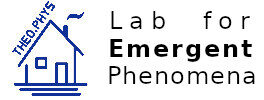Master thesis – Caroline Collischon
Caroline Collischon
Analysis of Structures in the Magellanic Clouds with Minkowski Tensors [PDF]
finished 2020-04
supervised by Klaus Mecke and Manami Sasaki
In this thesis, I develop morphometric data analysis methods for the detection of stellar bubbles with Minkowski tensors. Minkowski functionals and their generalization to tensors are shape descriptors from integral geometry. They characterize all additive shape information of unions of convex bodies, like in pixelated black and white images. Grayscale images can be analyzed by choosing a brightness threshold to define a discrete body and calculating them in a marching square. By averaging the resulting maps for several thresholds and smoothing, one obtains a Minkowski map at the smoothing window size. The irreducible Minkowski tensor ψ2 responds to elongated structures such as filaments and using its phase, lines perpendicular to the filaments are drawn.
Regions of high line density at a chosen smoothing window size show areas where structures of similar size should originate. Centers of bubbles then appear as regions of increased line density where the lines from the border meet. Additionally, the scale normalized |ψ2| falls or stagnates when increasing the window size. These two criteria are used to successfully detect bubbles in Hα, SII, and OIII images of the Magellanic Clouds. Noise impairs the detection, but leaving more noise in the images proves to be better than smoothing or choosing higher thresholds. The parameters need to be adjusted manually, but impressive results can be achieved without time-consuming optimization.
Bubbles are created by massive stars, so their respective distributions should be correlated. Methods of spatial statistics, so-called marked correlation functions, are used to compare the point patterns of detected bubbles and massive stars in the catalog of Bonanos et al. (2009). It is found that bubbles detected in Hα, SII, and OIII correlate with the stars as expected. The distribution of detected bubbles should thus represent the actual distribution of bubbles well. Line density maps at intermediate (70 px, 11.7′, 170 pc) and large scales (250 px, 41.7′, 600 pc) were also compared to the stellar distribution. The OIII data show the strongest correlation in both cases due to the more localized emission around present-day stars. The SII line densities do not correlate with the stars at any scale. The emission is more extended than the modern stellar distribution and likely older than the stars in the catalog. Hα correlates with the stars at 70 px, but not at 250 px, showing smaller, younger structures and larger older ones.
Additionally, a possible correlation of line densities at larger scales and supergiant shells is found. All nine LMC shells (Meaburn 1980) contain or directly border a local maximum of line density. The small sample size does not allow for a more precise statement. The line density may correlate to recent star formation in general.
